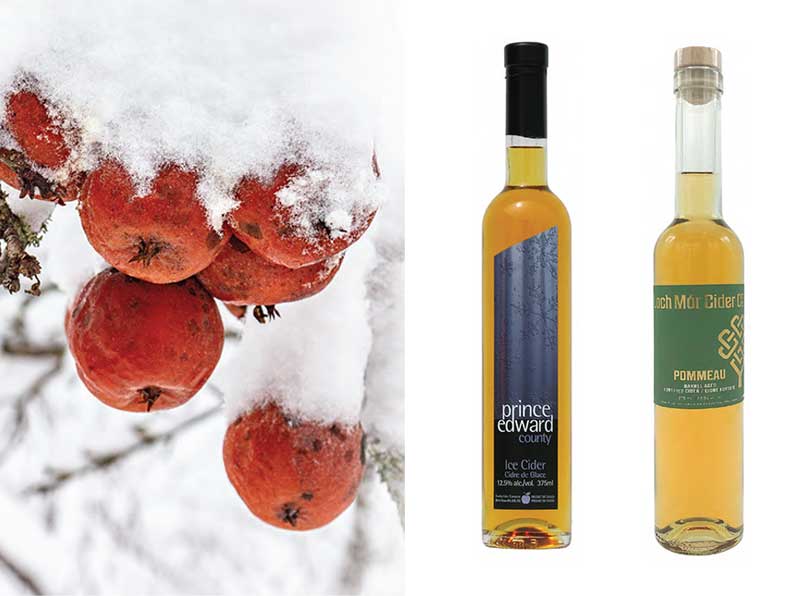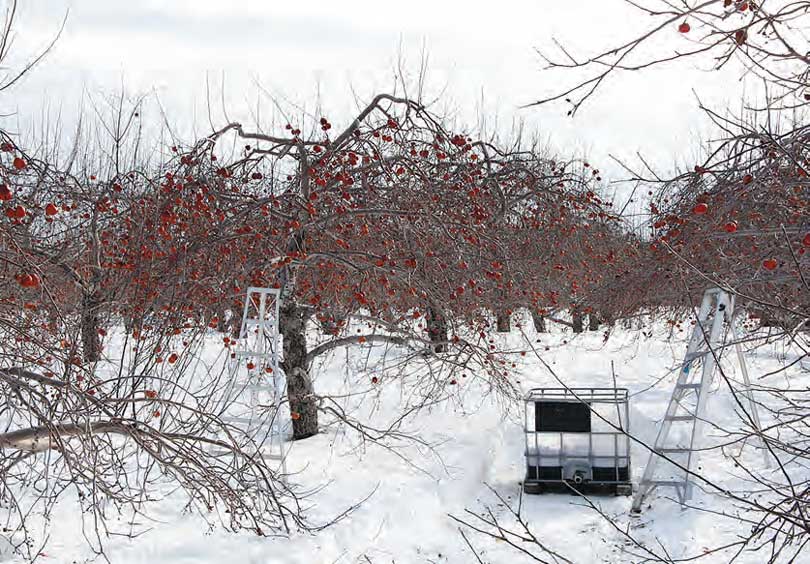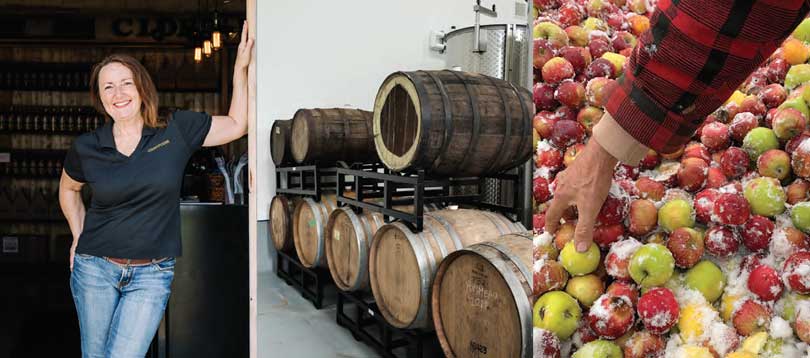


Jenifer Dean of the County Cider Company; barrels of fermenting Loch Mór Pommeau; Ida Reds waiting for processing
Two new takes on traditional cider
For many of us, the first cold snap of the season is an unwelcome sign of the coming of winter; but for some local apple growers, it’s the moment they have been anticipating for months. While to an outsider it may look like these growers have surrendered part of their harvest to the frosty conditions, exposing the apples to below-freezing temperatures is an integral part of a special process – the making of ice cider.
Ice cider is created by fermenting the juice of frozen apples to produce a concentrated aperitif, which can be paired with aged cheeses or desserts. Its taste is described as “a luscious mouth feel” that combines tartness with sweetness and is reminiscent of baked apples and crème brûlée. The cider’s flavour notes are just as intense as the way it’s made.
“You are totally at the mercy of the weather, as a good winter freeze is required if you are leaving apples on the trees,” says Jenifer Dean, General Manager and Cider producer at The County Cider Company in Waupoos, Prince Edward County – one of only a few ice cider producers in Ontario.
The method that Jenifer is referring to, known technically as “cryoextraction,” was created in 1989 by Christian Barthomeuf, a winemaker from Quebec’s Eastern Townships. He discovered that when you expose certain apple varieties to sustained temperatures of -15C to -8C, the combination of intensely cold winds and sunlight dries out the apples and naturally concentrates the sugars in the fruit. After cold-fermenting the pressed juice for an additional six to eight months, the resulting cider is packed with flavour without the need for any additives. However, the process does require triple the number of apples and labour just to produce the same amount of cider as traditional methods. There are approximately fifty cidermakers in Canada that use this process.
Jenifer recalls her first attempt using the cryoextraction method. “Ontario winters aren’t cold enough for long enough, so we had a really narrow window of time to pick the apples. Then imagine pressing hundreds of apples that are as hard as billiard balls!” she says.
Despite the challenges, the resulting product was so good that Jenifer decided to continue producing it, but with one crucial change to the process. “We now harvest the apples before they freeze thoroughly,” she explains. “By picking them earlier, we can extract more juice because they are not frozen solid. Then we freeze the juice in a commercial freezer. When we are ready to make the cider, we only ferment the first portion which contains all the sugars and flavours, and leave behind the frozen water.”
Another advantage to adopting this new method of “cryoconcentration” was that she had more control over the fermentation process, and therefore the flavour notes.
“We don’t ferment to complete dryness. We also cold-ferment some varieties in locally-made Coach barrels. The County oak, ash, cherry, and hickory wood gives the cider hints of smokiness and spice,” she says.
These barrel-aged varieties have garnered Jenifer multiple awards at the prestigious All Canadian Wine Championships (ACWC) and at the Great Lakes International Cider and Perry Competition (GLINTCAP), the world’s largest cider competition. She attributes her success to the one thing that hasn’t changed throughout her process: the right combination of apple varieties.
“The apples are key. We were so lucky that one of the first combinations we tried of Ida Red, Golden Russet and Northern Spy really worked for us. We didn’t lose time experimenting too much,” Jenifer recalls.
Certified Pommelier Sara Boyd from Loch Mór Cider Company in nearby Hillier agrees.
“Gary and I travelled all over the world to find the right varieties of apples that, combined with the County’s rich limestone soil and our weather, could produce the kind of dry cider we wanted to make.
The Boyds’ 10-acre orchard is populated with 29 heritage varieties such as Kingston Black, Dabinett, Muscadet du Dieppe, and even Harrison apples (a variety that was thought lost until 1976 when a single tree was discovered in New Jersey and used to repropagate them throughout North America).
The Loch Mór Cider Company has the distinction of being the first Harrison cider producer in Canada, and the second cidery in Canada to produce a fortified cider – their answer to ice cider.
“We were inspired by the apple brandy producers in Normandy who distill their cider into a white spirit called eau-de-vie, which is barrel-aged to make brandy,” explains Sara. “We blended our eau-de-vie with a lightly fermented cider, barrel-aged it for twelve months, and filtered it to create our Pommeau.”
She adds, “Like ice cider, the flavours are still sweet and strong, but it’s refreshing on the palate and has a much higher alcohol content.”
The Boyds’ Pommeau has also been recognized with awards from the ACWC, GLINTCAP, and has won the CiderCraft International Award and a 2021 silver medal at the national WineAlign awards. Despite the accolades, Sara explains why not all cideries are producing it.
“We were inspired by the apple brandy producers in Normandy who distill their cider into a white spirit called eau-de-vie.”
SARA BOYD
“The process is very exacting – in addition to having a foundation in chemistry, you also need to have enough experience to modify the process along the way. When Gary and I started there were not a lot of resources available to us, or people that we could ask for help. Now there are more programs offered at local colleges and more of us to ask,” she says.
Although demand for both ice cider and fortified cider is higher than ever, their creators worry that climate change may threaten future production of this unique local product.
Jenifer Dean remarks, “We can make all sorts of changes to our process, but making great ice cider depends on getting a cold enough Canadian winter. Fingers crossed!”
Our cider makers are hopeful that we’ll warm up to the idea of a cold winter.
Visit: countycider.com or lochmorcider.com.
Story by:
Micol Marotti




